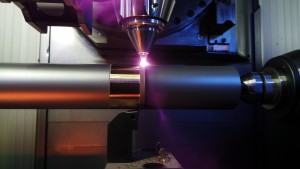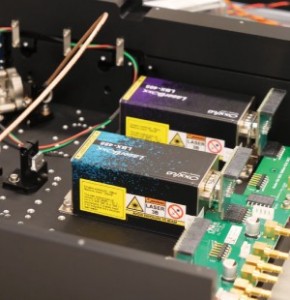
SMaC allows high-strength coating materials to be applied quickly and efficiently and machined simultaneously. SMaC will enable the industry to produce components with an extended service life and extended operating cycles, an advantage that is highly attractive for the energy industry, the mobility sector and the chemical industry. SMac, which stands for Simultaneous Machining and Coating, combines laser material deposition with turning, grinding or milling.
Coatings are something like hidden champions: Hardly noticed, they do great things. They help protect components from all kinds of damage and wear. They improve the physical or chemical properties of component surfaces or give them certain functions. They can also help save energy thanks to their insulating or reflecting properties.
A new, patented combination process developed at the Fraunhofer Institute for Laser Technology ILT – Simultaneous Machining and Coating (SMaC) – also improves the energy footprint in another way. “We have combined mechanical machining with extreme high-speed laser material deposition EHLA in a single process step,” explains Viktor Glushych, head of the Coating LMD and Heat Treatment group at Fraunhofer ILT. “This allows us to shorten processing times significantly,” he says. Depending on the requirements profile and coating material, the process time can be reduced by more than 60%.
SMaC solves a fundamental problem of high-strength protective coatings that protect against corrosion and wear: The harder the coating, the better the protection, but the more complex the post-processing. What is unique about SMaC is that it utilizes the residual heat generated in the EHLA process.
Immediately after laser material deposition, the coating materials exhibit only a fraction of their hardness since there is residual heat of several hundred degrees Celsius. In mechanical processing, which takes place in parallel, the tool can be operated at higher cutting speeds because the coating material is softer when it is processed immediately after its deposition.
“With SMaC, we can apply corrosion- and wear-resistant coatings economically. We achieve significantly higher surface qualities and potentially longer tool life than with the usual sequential machining,” clarifies Glushych. The EHLA process can be used to process high-strength coating materials – even high-entropy alloys or metallic glass, which can hardly be machined using conventional methods.
Applications for SMaC
SMaC allows users to coat components in a highly productive, economical and versatile manner. However, the new process is also interesting from an ecological point of view because components can remain undamaged in use for significantly longer, thus making their replacement less frequent. “SMaC decisively extends the service life, operating cycles and maintenance intervals of components, assemblies and entire machines,” explains Glushych. “This increases the raw material and energy efficiency of the components and minimizes machine downtimes.”
Fewer spare parts mean less raw material usage, less maintenance, less transport and warehousing. For many companies, this means they can work more independently and plan more reliably – in other words, they achieve greater production resilience. In recent years, for example, some companies have been slowed down by very long delivery times for functional metallic components. SMaC would help counter this trend.
“SMaC is efficient and saves energy, time as well as resources,” says Glushych, describing the advantages. In principle, the process is suitable for all applications in which components were previously coated and machined subsequently. It can be used, for example, to produce coatings for corrosion and wear protection, coatings with hard and soft magnetic properties or to produce extremely resistant plain bearing coatings and other functional surfaces.
Applications can be found, for example, in the energy industry and the entire mobility sector – wherever highly stressed, rotationally symmetrical components are required. In the chemical industry, for example, surfaces have to withstand highly aggressive substances. In mining or for tools SMaC successfully protects against wear and tear. Not only are the areas of application numerous, but they are also diverse.
Glushych is thinking one step ahead: “In the context of the upcoming Euro 7 regulations, EHLA coating of brake discs is considered a very promising solution to reduce particulate emissions during braking. With Simultaneous Coating and Machining, we can manufacture certain brake disc coatings faster and more productively,” he reflects. “Another application we want to test is the production of multi-material coatings in battery technology.” The scientist is certain this new combination process will open up many new fields of application for laser-based coating technology in the near future.
See SMaC at LASER World of PHOTONICS in Munich from June 27 to 30, 2023, booth: A3.441 and World of Quantum: A1.521.































 Back to News
Back to News



























